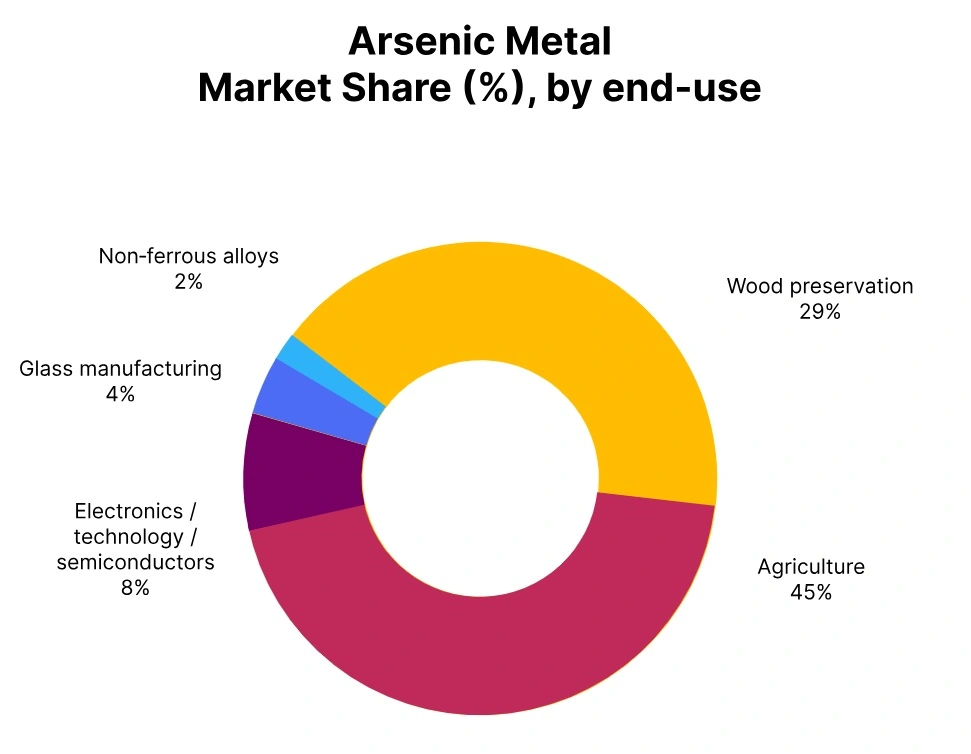Price-Watch’s most active coverage of Arsenic Metal price assessment:
- Purity: 99%min. FOB Shanghai, China
- Purity: 99%min. CIF Nhava Sheva (China), India
- Purity: 99%min. CIF Rotterdam (China), Netherlands
- Purity: 99%min. CIF Houston (China), USA
Arsenic Metal Price Trend Q3 2025
In Q3 2025, arsenic metal prices showed a continued downward trend across global markets, driven primarily by weak demand from key sectors like semiconductors and electronics, combined with ample supply particularly from China. Oversupply pressures and cautious downstream procurement kept prices soft, with North America and Europe experiencing declines of around 5 to 8% from the previous quarter.
Despite relatively stable production costs and occasional environmental curbs, these factors were insufficient to offset the sluggish market sentiment, keeping arsenic prices under consistent pressure throughout the quarter.
China
Arsenic Metal Export prices FOB Shanghai, China, Grade 99%min.
According to PriceWatch, in Q3 2025, the price trend of arsenic metal in China showed a 3.08% decrease compared to Q2, driven by weak downstream demand from the semiconductor and battery sectors, elevated inventories, and stable domestic supply.
Despite relatively low production costs, Chinese producers faced continued pressure to reduce prices amid limited procurement activity and cautious buyer sentiment. The average market price for 99% arsenic metal hovered, reflecting bearish conditions. Without a significant rebound in industrial demand or government stimulus, the market is expected to remain soft in the near term.
Arsenic metal prices in China decreased by 1% in September 2025, primarily driven by reduced demand from the semiconductor and alloy industries, coupled with stable or slightly increased production levels. Additionally, subdued export activity due to global economic uncertainty contributed to the downward pressure on prices.
India
According to PriceWatch, in Q3 2025, the arsenic metal price trend in India recorded a 1.58% decrease compared to the previous quarter, driven mainly by subdued demand from downstream industries such as electronics and metallurgy, along with steady supply levels and marginal cost easing. Competitive import pricing, particularly from China, and conservative procurement activity also contributed to the downward pressure on prices.
While the decline is moderate, it reflects a cautious market sentiment amid stable input costs and regulatory oversight. The outlook remains neutral to slightly bearish unless demand conditions improve or supply disruptions arise.
The 0.6% decrease in arsenic metal prices in India during September 2025 can be attributed to subdued demand from the semiconductor and alloy industries amid global economic uncertainty. Additionally, more imports and higher inventory levels contributed to downward pressure on domestic prices.
USA
According to PriceWatch, in Q3 2025, the arsenic metal price trend in U.S. witnessed a modest 0.87% decline in prices compared to Q2, continuing the downward arsenic metal price trend driven by less demand from key sectors like semiconductors and electronics. Despite stable import availability and easing freight costs, buyer sentiment remained cautious, with many downstream users maintaining minimal inventory levels amid ongoing macroeconomic uncertainty.
The market displayed signs of stabilizing after sharper declines in previous quarters, but without a strong recovery in industrial demand, particularly from high tech applications, significant price support remains unlikely in the short term.
The 0.6% decrease in arsenic metal prices in the USA during September 2025 can be attributed to subdued industrial demand, particularly from the semiconductor and alloy sectors. Furthermore, improved global supply chains and increased exports from major producers like China may have contributed to the price dip.
Netherlands
In Q3 2025, the arsenic metal price trend in the Netherlands experienced a 1.13% decline compared to Q2, reflecting a continuation of the downward price trend of arsenic metal across Europe. This dip was driven by subdued demand from downstream sectors like electronics and semiconductors, along with stable but unremarkable production and import dynamics.
Competitive pricing from suppliers across the globe, especially China, and cautious inventory management further pressured the market. Despite stable logistics and input costs, weak industrial activity and limited restocking contributed to the overarching softness. Unless demand rebounds in Q4, the market may see continued marginal declines.
The 0.78% decrease in arsenic metal prices in the Netherlands in September 2025 can be attributed to reduced industrial demand amid slowing semiconductor and glass manufacturing sectors. Additionally, stable global supply levels and easing import costs contributed to the downward price pressure.



